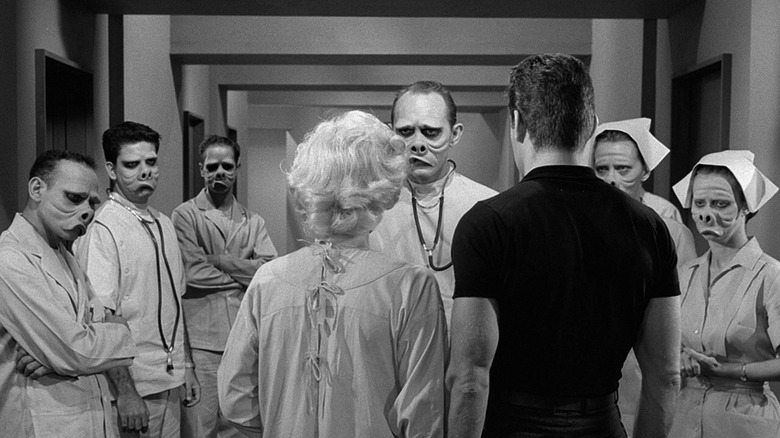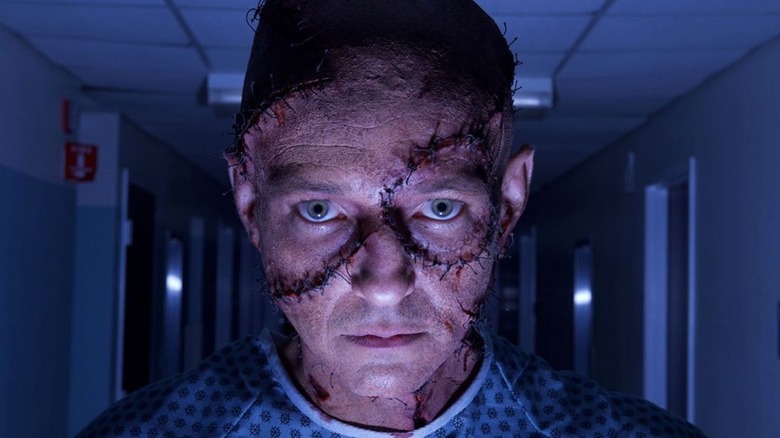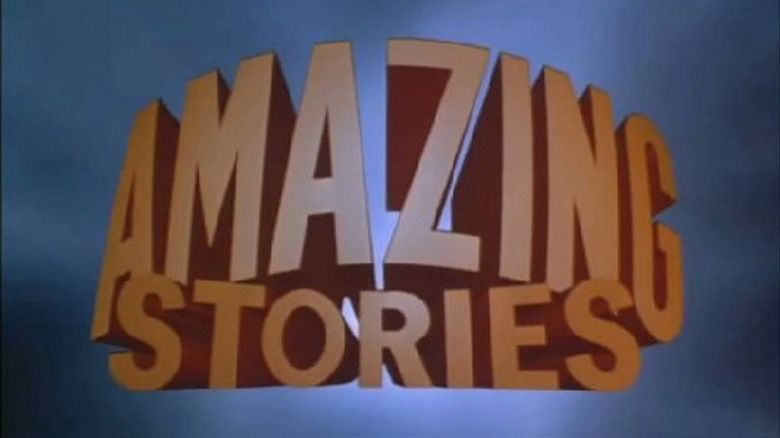Mick Garris's Love For Anthologies Started With The Twilight Zone
Anthology horror has been a staple of the genre for decades. Gaining popularity in the late 1950s with primetime episodes and evocative storylines on "Alfred Hitchcock Presents" and "The Twilight Zone," these quick morality tales were easily digestible to mainstream audiences. In a time when film and television didn't yet have a complete stranglehold on pop culture, anthologies still retained the feeling of reading a collection of short stories. Many of the episodes were based on terrifying yarns penned by acclaimed authors such as Roald Dahl and Richard Matheson, resulting in some of the most memorable episodes like "Man From the South" starring Steve McQueen and the monster on a plane classic "Nightmare at 20,000 Feet" featuring a very young, very paranoid William Shatner.
Rod Serling wrote what was, arguably, the most famous episode of "The Twilight Zone" called "Eye of the Beholder" where a young, supposedly disfigured woman undergoes surgery only to discover that her masked surgeons have reconstructed her face to look like a pig. It's ridiculous and frightening simultaneously, as only the best anthology stories are.
Mick Garris, the stalwart ambassador of the horror genre, fell in love with anthologies as a young kid, way before he would go on to direct episodes of Steven Spielberg's '80s adventure series "Amazing Stories," the "Nightmare on Elm Street" spin-off "Freddy's Nightmares" and the made-for-TV adaptations of Stephen King's "The Stand" and "The Shining." Garris would also go on to create "Masters of Horror" for Showtime — featuring a collection of uncensored episodes from the top names in the genre — and has remained a staple on the horror trail, appearing at numerous conventions and in-depth panel conversations over the years. Such an event took place when the British Film Institute's horror branch, Grimmfest, hosted a talk between Garris and British actor Reece Shearsmith to discuss their passion for anthology horror in November 2022.
'It blew my mind'
In an interview with Fangoria, Mick Garris and Reece Shearsmith happily recalled their history and involvement with the anthology format, and why Garris, in particular, loves telling these kinds of stories. Garris happened to be the perfect age to become enraptured by the early days of short-form genre storytelling. "As a child of the '50s and '60s, I started watching 'The Twilight Zone,' which was released in 1959. It blew my mind," Garris recalled. "Then, later in high school, my first interviews were actually with the show's creator Rod Serling and influential writer Ray Bradbury."
Speaking alongside Shearsmith, the writer and creator of the long-running UK dark comedy anthology series "Inside No. 9," Garris touched on just how limited his access was to the seminal anthologies from across the pond. "There was very little exposure to British horror over here until the Amicus releases of 'Tales From the Crypt' and 'Vault of Horror.' As a comic book fan, I would read the reprints of EC Comics, so naturally, I loved the movies when they came out," he said.
By the time Garris wound up directing a few episodes of "Tales From the Crypt" first aired on HBO in 1989, that British sensibility had been fully Americanized. "It was very crass and became the 'boobs 'n' blood' show that took advantage of the uncensored cable channel," Garris pointed out in regards to the new iteration hosted by the kid-friendly Crypt Keeper.
Garris's love for anthologies would extend even further with the devilishly fun midnight anthology movie "Nightmare Cinema" (reviewed by /Film's Matt Donato here), where Garris produced and directed a segment alongside other notable genre filmmakers such as Joe Dante and Alejandro Brugués.
'It's not at all what you expect it to be'
2018's "Nightmare Cinema" may be Mick Garris' most recent foray into anthology horror, but his roots go all the way back to the fantasy adventure series "Amazing Stories," which ran for a short yet memorable run from 1985 to 1987. "Steven Spielberg's 'Amazing Stories' was my first job as a director. I've always loved that anthologies provide these little movies you can watch on television and that they're self-contained," he told Fangoria.
Rightfully, Garris then turned his attention to Reece Shearsmith's contributions to the continually expanding world of anthologies, praising the long run of his show "Inside No. 9" and the constant guessing game that the popular British show always embraces. "I'm so thrilled there are now eight seasons of 'Inside No. 9,' which is just killing it all the time. No matter which episode you choose, it's not at all what you expect it to be, and just when you think you've figured it out, there's another left turn."
In that last comment, Garris crystallized the reason why the anthology structure is so compelling and appealing to people across generations. Because of the twisting, zigzagging nature of these shows, there's never a dull moment. In an age where viewers are more savvy than ever before, unpredictability is of paramount importance if filmmakers want their audience to stay engaged. Perhaps the most important reason anthologies have stood the test of time is the knowledge that if you don't like a particular story, there's always another one waiting just around the corner.


